Financial aid •
June 30, 2022
How to pay for college
College will be one of the biggest expenses of your early adult life, and it comes at a hefty price tag. Here are 8 tips to help you pay for college.

Are you planning to attend college soon? If so, just as important as figuring out how to get into college is figuring out how to pay for it.
The cost of attending a college or university is one of the largest expenses you’ll have in your early adult years. And the fact is that it just keeps getting more expensive.
In the last 20 years, tuition and fees in the US have risen by more than 140%.
Paying for college can certainly feel overwhelming, but it’s not impossible. In fact, billions of dollars in financial aid go unused every year. Why? Because finding and applying to all the financial aid you qualify for can be really hard. But it doesn’t have to be.
We’ve rounded up 8 of the best strategies to help you get all the money you need to pay for college, so that you can go to the school of your choice.
How much money will you need?
One of the most challenging parts of getting ready for college is figuring out just how much it’s going to cost you.
Let’s be honest, university websites haven’t always been exactly upfront about the cost. And while they’ve become more transparent, expenses such as room and board, fees, and textbooks can often add up to be just as much as the tuition itself.
According to EducationData.org, the average annual cost of tuition at a 4-year public university is about $9,580. But that’s not your total out-of-pocket cost.
Once you add in all of the extra expenses, the average cost of attendance actually comes to about $25,864 per year. In the end, it’s not unusual for a college degree to have a price tag of around $100,000.
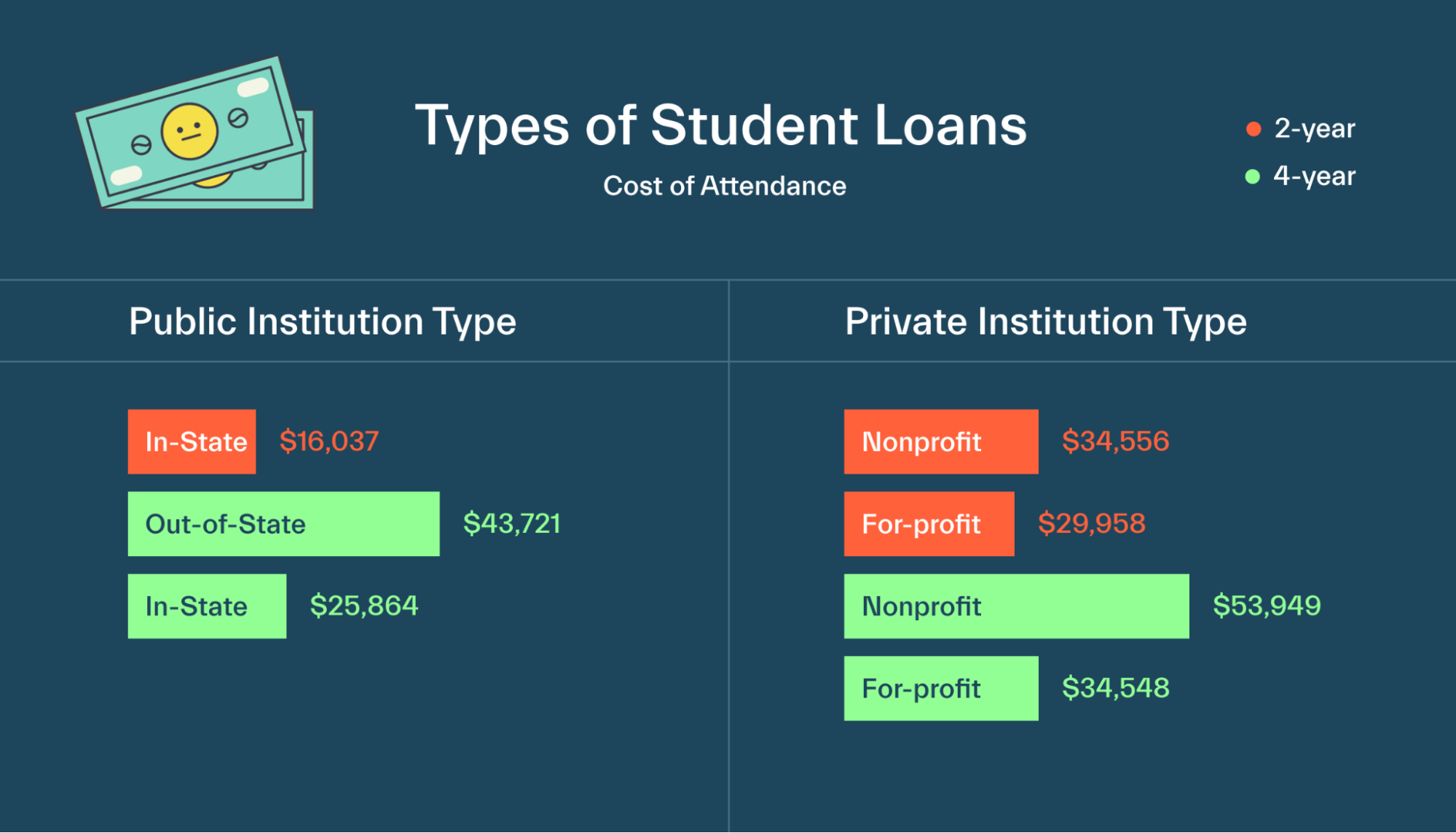
2 of the biggest factors in determining your costs are the type of school you attend and whether you’re paying in-state or out-of-state tuition.
Private schools usually come with a bigger price tag than public schools, and staying in-state is usually cheaper than going out-of-state. If you opt for a 2-year school and transfer to a 4-year, you could cut your costs by more than half.
There are also plenty of other variables to consider. The price of college will depend on your region, your state, whether you choose to live on campus, how willing the college is to discount your tuition, and so many other factors. But these numbers give you a starting point to help you plan your overall college expenses. Now, let’s look at how you can come up with the money you’ll need.
8 ways you can pay for college
Here are 8 different ways you can cover some or all of your college expenses:
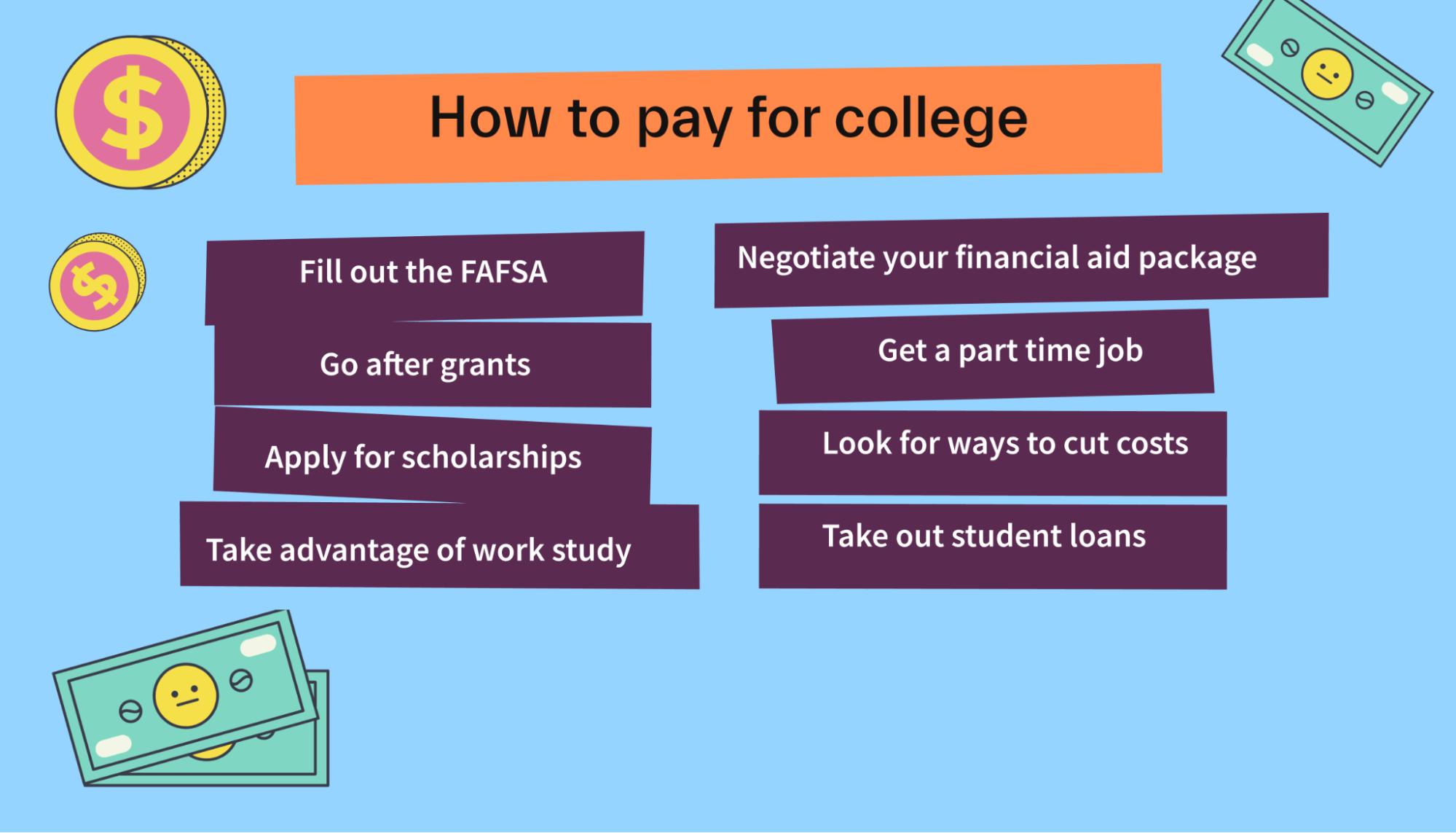
Fill out the FAFSA
The Free Application for Federal Student Aid (FAFSA) is a federal form that determines whether you’re eligible for financial aid from the federal and state government, colleges, and universities.
Regardless of your financial situation, filling out the FAFSA should be your first step when it comes to funding your college education.
The FAFSA collects information such as your family’s household income and assets to determine what type of aid you might be eligible for. Once you’ve filled it out, you’ll get a financial aid offer from your school that explains what exactly you qualify for.
You might think that the FAFSA is only necessary for low-income families who expect to qualify for federal grants, but the fact is, you need a FAFSA on file to get most financial aid––whether it be from the state or your school––so it’s important to submit one regardless of your circumstances.
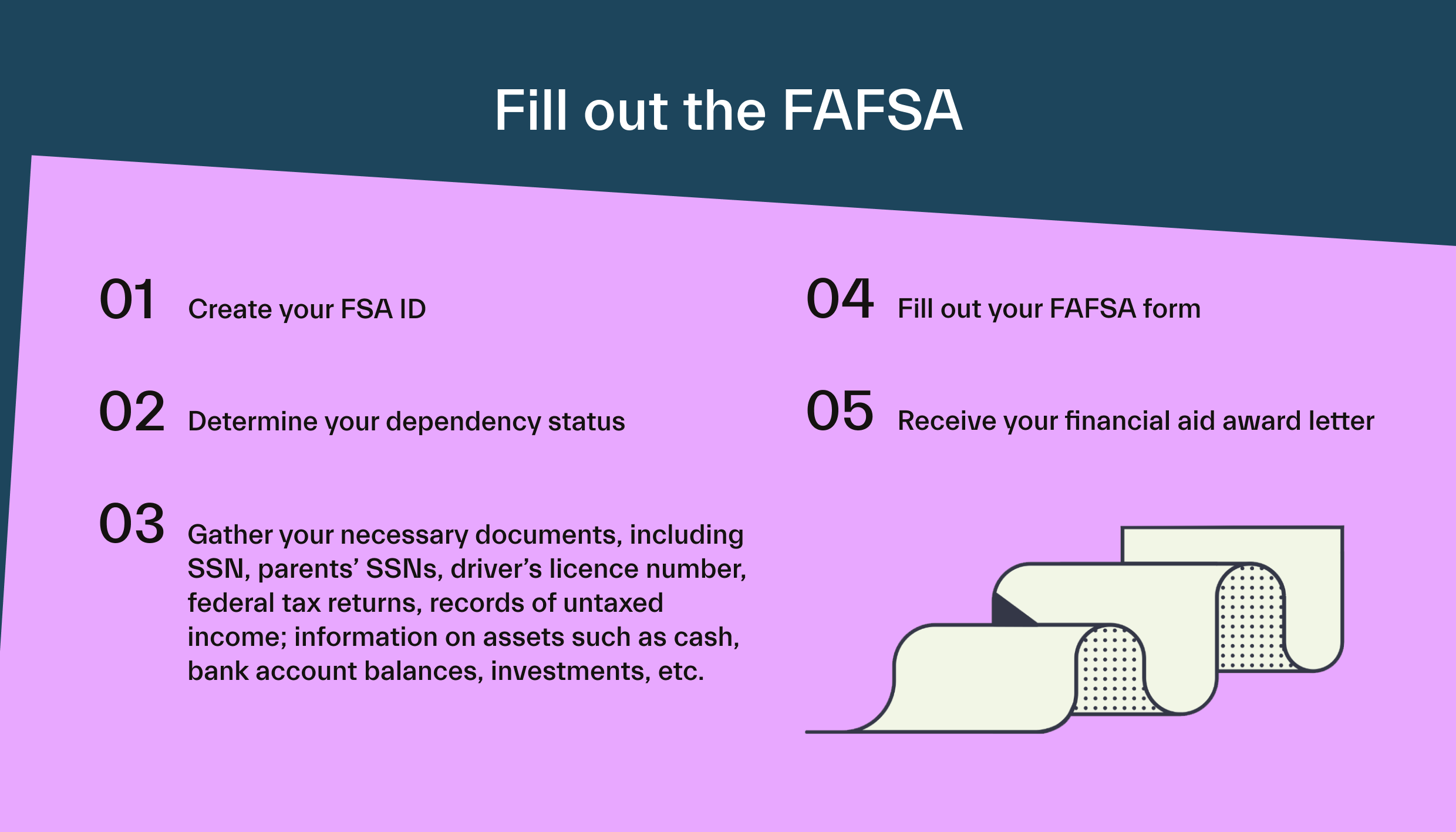
Want help filing the FAFSA? Work with a Mos financial aid advisor to ensure you get the most financial aid money possible. Mos members can work 1-on-1 with an advisor to create a custom financial aid plan, submit the FAFSA, find relevant scholarships, and much more!
Go after grants
A grant is a type of financial aid that’s a part of your aid package. Grants are literally free money, meaning that, unlike student loans, you won’t have to pay them back.
The most common grant is the Federal Pell Grant, but there are also grants available through state governments and universities (many of which students don’t know about). A lot of students assume that if they don’t qualify for the Pell Grant, they won’t qualify for any other grants. But that’s often not the case. You don’t have to be low-income to get grants––you just have to have financial need. Financial need basically means that your Expected Family Contribution (EFC)––that number that you get after you submit your FAFSA––is lower than the cost of attendance (COA) of your college. That means, even if your EFC is high, you might have financial need at a more expensive college. That’s why we suggest everybody, no matter your financial circumstances, fill out the FAFSA early, fill out any extra applications for state grants, and apply to any additional grants your college offers.
Apply for scholarships
Like a grant, a scholarship is free money that you don’t have to pay back when you graduate. But unlike grants, scholarships are available to more students. You don’t necessarily have to have financial need to be eligible.
There are literally hundreds of thousands of scholarships available, so you have a good chance of finding at least a handful that you qualify for. They often come from private organizations, companies, nonprofits, and more.
Scholarship eligibility can be based on any number of factors, including your age, college major, state, race or ethnicity, GPA, personal hardship, special skills, and many more.
Still, we know that finding scholarships that are the right match for you can be challenging. Finding scholarships is easier than ever when you sign up for Mos. Mos’s database of scholarships allows you to filter out the scholarships you don’t qualify for, so you just apply to ones that are worth your time.
Take advantage of work-study
Work-study is another type of federal financial aid available to students who demonstrate financial need.
When you qualify for work-study, you can gain part-time employment at the school where you’re enrolled.
The work available can include both on-campus and off-campus jobs. There’s a wide range of jobs available, and you can find one that best fits your skill set.
The amount you earn through work-study depends on your location and the job you find. But, you’re guaranteed to earn at least the minimum wage where you’re located.
For jobs that require special skills, you can earn even more.
Then, the money you earn can be used to pay for college tuition or cover other living expenses while you’re in school.
Appeal your financial aid package
After you complete your FAFSA, you’ll receive a financial aid award letter telling you exactly what aid you’re eligible for.
But here’s something your award letter won’t tell you: you can appeal your financial aid package.
But, you can’t simply call the school you’re attending and ask for more money. Instead, you’ll have to put your request in writing to initiate the professional judgment review.
This review allows your school’s financial aid office to adjust or override parts of your FAFSA or aid package.
Make sure your letter explains exactly why you’re appealing your aid amount. Here are a few situations where you might be able to appeal:
Your family’s financial situation has changed. If your family income is less than what’s reflected in your FAFSA, you may be eligible for more money.
Your academic record has improved. Some aid is merit-based, meaning your school might be willing to provide more aid for a better academic record.
You have financial aid offers from competing schools. Schools want to attract the best students. If you’re a high-achieving student, a school might be willing to increase your aid to make sure you accept its offer.
When you mail your appeal letter, be sure to include any supporting documents that help your argument.
Documents could include high school transcripts, family tax returns or W-2 forms, copies of your offer letters from other schools, and more.
Finally, follow up. Call the school to verify they’ve received your letter. Don’t be pushy, but show that it’s important to you and that you really want to attend their school.
Negotiate your financial aid package
Even if you don’t have grounds to appeal your financial aid package, you may still try to negotiate for more money. That’s right—you can simply ask a college for more money. When you do, make sure to show the gap between your EFC and what the school is asking you to pay. This strategy, especially for new students, could help you to land tuition discounts.
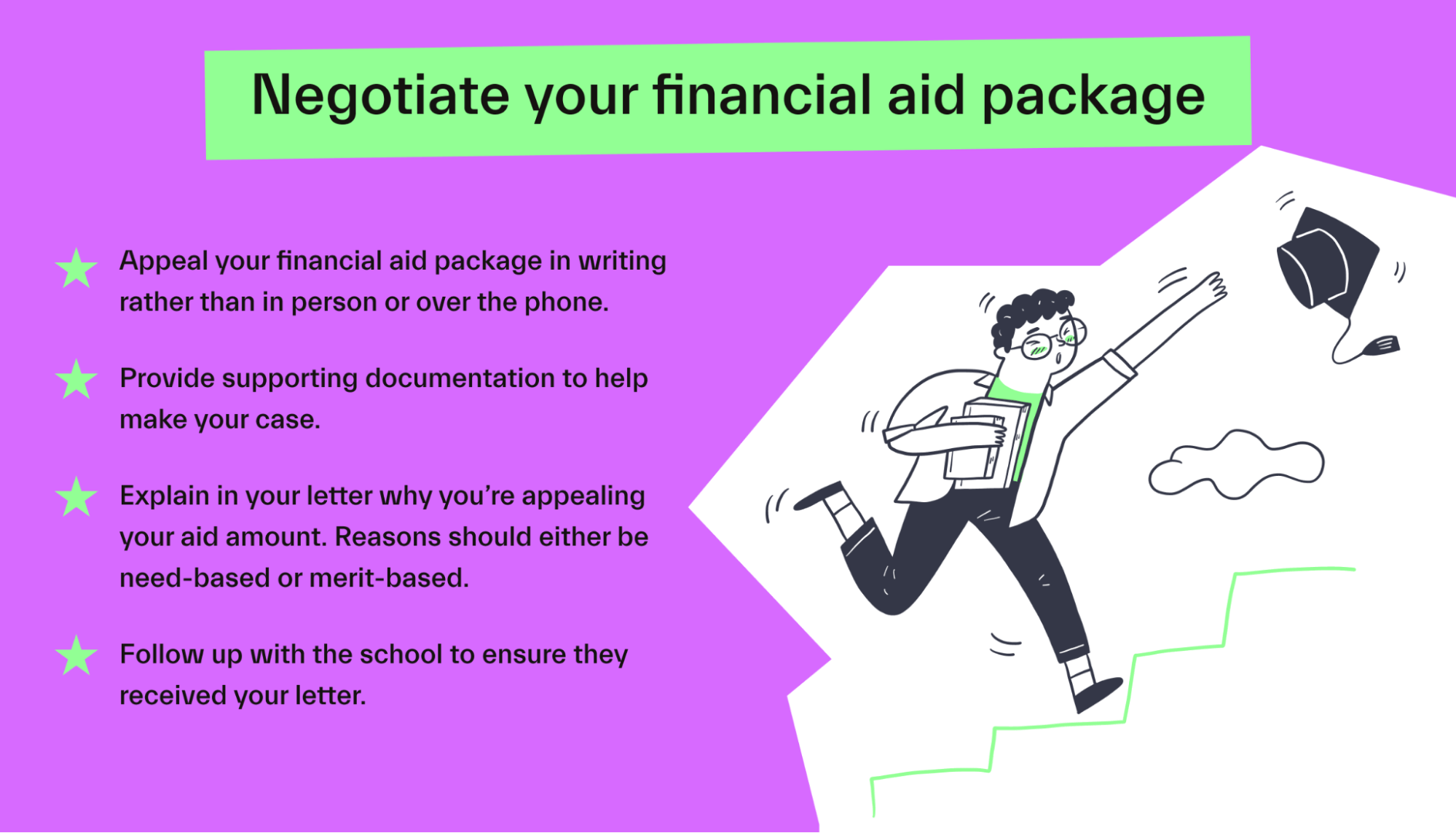
Negotiating your financial aid or tuition with your school can feel intimidating. If you’d like guidance, join Mos today. A Mos advisor can help you draft negotiation letters, come up with a personalized financial aid plan, and ensure you get every dollar possible.
Get a part-time job
Work-study is a great way to earn extra money to pay for college, but it’s not available to all students. And even if you do qualify, you’re only eligible to earn a finite amount of money. The good news is that work-study is hardly the only job opportunity available.
First, look on your school’s website to see what job postings might be there.
Not all the school’s part-time jobs are only available to work-study recipients. You can apply everywhere, from your school’s cafeteria to the library to a particular academic department.
You can also look for jobs specific to your college major. For example, if you’re studying journalism, contact your school’s newspaper and ask if they pay writers and editors. It likely won’t be much money, but any little bit can help.
Finally, look for other part-time jobs available.
There are likely plenty of retail and foodservice jobs nearby, as there often are in college towns. And thanks to the digital age we’re living in, you aren’t limited to just local jobs. You can also go online and look for remote jobs.
Look for ways to cut costs
College is expensive, and there’s often no way around that. But there are definitely steps you can take to reduce your costs, making your college education more affordable.
Here are 7 ideas for reducing your costs while in college:
Find a more affordable school: One of the quickest ways to reduce your college cost is to choose a different school. This might be a tough pill to swallow if your dream school comes with a big price tag, but if you really want to save money, it’s often your best option. Consider a community college or a state school where you get in-state tuition.
Become a resident assistant (RA): Schools hire students as RAs to live in the residence hall and act as a resource for students in the building. RAs usually receive free room and board, which can save you a lot of money.
Rent or buy used textbooks: The textbooks required for most college courses are expensive. And once the semester is over, you no longer need them. Rather than paying full price for textbooks and selling them for a fraction of the price later, look into renting your textbooks or buying them used.
Consider alternative housing options: Living in the dorm might be the most fun when you start college, but it’s not the most cost-effective. If you’re going to school nearby, the cheapest option is likely living at home with your parents. You might also save by finding an off-campus apartment with roommates.
Limit your spending money: It’s easy for spending to get out of control when you’re in college. It’s the first time you’re really in charge of your own decisions. And with lots of friends around, it’s easy to overspend on eating out, alcohol, and shopping. Put yourself on a budget so you can spend a certain amount of ‘fun money’ each month without it getting out of hand.
Use student discounts: There are many businesses that offer student discounts to college students, especially in college towns. It never hurts to ask when you’re out shopping if the store has a student discount. Your school might even maintain a list of local businesses with discounts for students.
Take out student loans
Even if you’ve tried all of the strategies we shared, there’s a possibility that you might need more funding. In that case, it’s time to look at student loans.
There are 2 primary categories of student loans: federal and private. If you’re eligible for federal loans, those will be listed on your financial aid award letter.
Student loans from the federal government come with some perks that you won’t find with private loans, and so if you qualify, it’s likely best to borrow those first. They come with a low fixed interest rate no matter what your credit score is. And if you demonstrate financial need, you can get a subsidized loan, which doesn’t accrue interest when you’re in school.
Federal loans also come with perks after graduation, such as the option of an income-driven repayment plan (where your payment amounts are based on your income) and the potential for loan forgiveness (which reduces or eliminates the amount you owe).
Also, throughout the COVID-19 pandemic, the federal government paused interest and monthly payments on all federal loans. That wasn’t the case for private loans.
If you don’t qualify for a federal loan or don’t qualify for enough to cover your entire cost of college, then you can turn to private loans.
There are many lenders that offer private loans. They typically require you to prove your creditworthiness, but you may be eligible for lower rates if a parent can co-sign your loan.
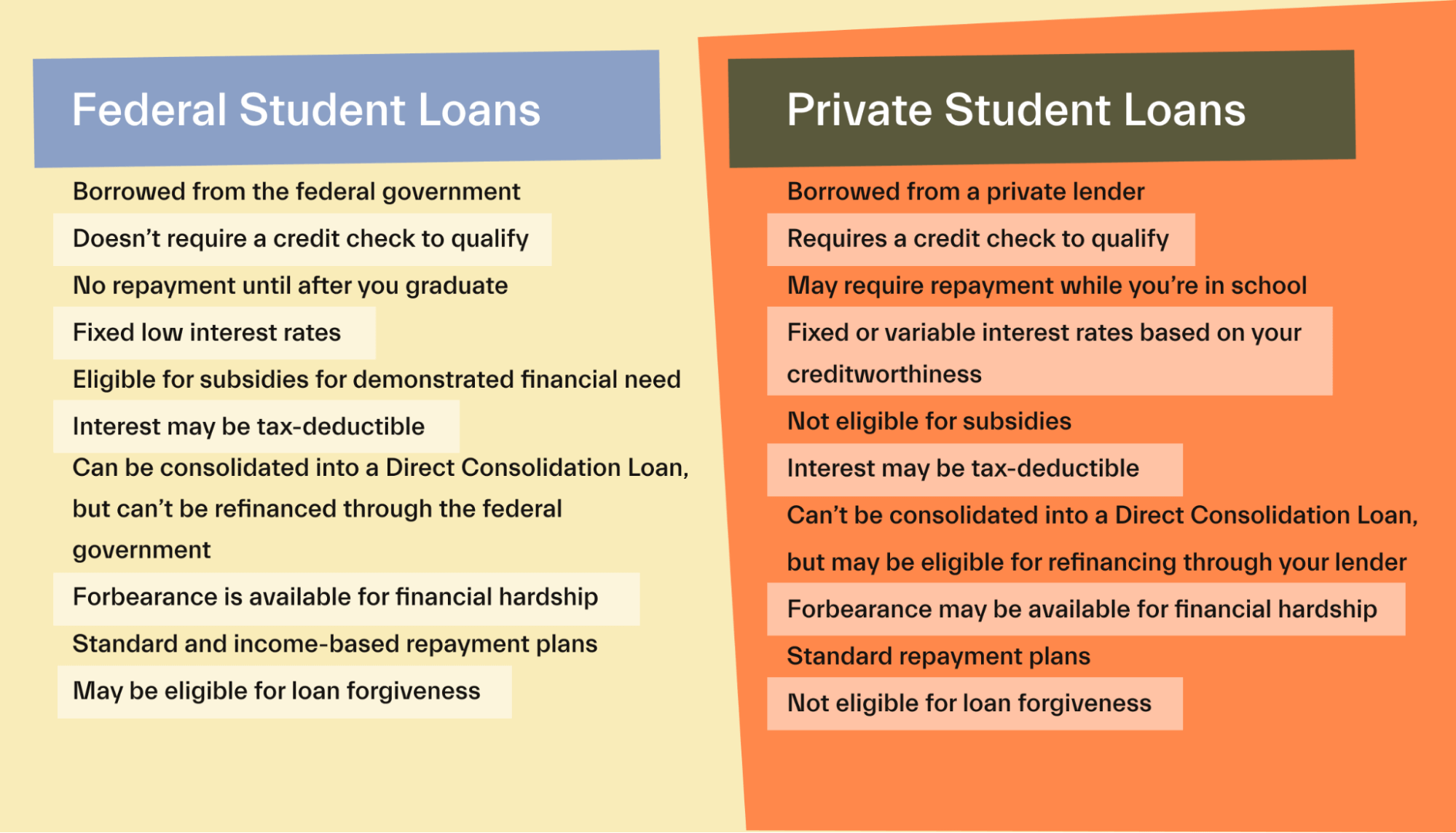
Conclusion
There’s no doubt that higher education is expensive, and just thinking of how you’ll pay for it can be overwhelming.
Luckily, there are still plenty of options to help you pay for college, often without having to go into massive student loan debt.
One of the best first steps you can take is to complete your FAFSA form to learn what kinds of financial aid you might be eligible for.
Want to maximize your finances? Mos can help! Mos is a money app for college students that helps them get the most free money for school possible. It gives students personalized guidance, easy-to-use tools, and access to the largest scholarship pool in America. Explore Mos memberships today.
Let's get
your money
- Get paired with a financial aid expert
- Get more money for school
- Get more time to do you








